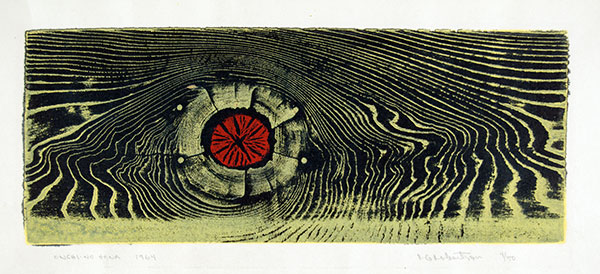This delicate woodblock print by Ronald Robertson (born Detroit, MI 1927) captures in relief a cropped perspective of the swirls of tree rings encircling a reddened knot, recalling the perspective of a flower blooming from above. A few years following Robertson’s attendance as a student at Black Mountain College in 1951, he left for Japan for an extensive 10-year study of Japanese printmaking, calligraphy, and paper assembly under various mentors and at Sohpia University, Tokyo. In 1965, a year before returning to the United States, Robertson published a book titled Contemporary Printmaking in Japan, which synthesized his learning of Japanese woodblock techniques and highlighted the works of six contemporary Japanese woodblock artists. One artist he discusses is Hagiwara Hideo (1913–2007), who in 1958 began making abstract prints featuring the textures of found objects and materials, especially wood, and using minimal color palettes to draw attention to the surface of the printing block. Robertson was then new to printmaking as a maker, but he crafted his own abstract language in painting in the early 1950s, as exemplified in the geometric abstraction Studies Building at Black Mountain College (1951). As in this earlier painting, Robertson transforms a 3D landscape into a succinct, 2D design in the Onchi No Hana print. However, instead of outlining the shapes in the work himself, Robertson used the naturally arising textures in the woodblock to create pre-defined shapes, influenced by his exposure to artists such as Hagiwara. Rings, read flatly along the cross-section of a tree here, define points across a three-dimensional space, enclosing the location of a single flower.
The work’s title Onchi No Hana (Onchi’s Flower) offers two potential avenues of metaphorical significance for further understanding. The phrase “Onchi No Hana” translates from Japanese to English as “tone-deaf flower”. Visually isolated from the undulating rings of the woodblock, the central flower appears as if sequestered from its environment. Its intense, red hue and circular shape also exaggerate the flower as the focal point. The rings, transformed into permeating waves of sound, surround yet never reach the subject. Alternatively, or additionally, the title may also refer to the prints of flowers by Japanese woodblock artist Kōshirō Onchi (1891–1955), whose artwork Red Flower (1948) is similarly abstract and depicts a lone red flower on a muted background. Both Hagiwara and Onchi contributed to the Japanese Sōsaku-hanga (“creative prints”) movement in the 20th century, which demonstrated a transition from traditional Japanese woodblock production focusing on duplication and collaboration to one which focused on expression and individuality.
For Robertson, using found materials in his printing practice seamlessly aligned with lessons at Black Mountain College seeking to break down boundaries between form and content (among many other boundaries). Students at the college under the direction of Josef and Anni Albers made Matière Studies, combining paper, cards, leaves, and other common materials for the sake of exploring fundamental visual aspects of texture, color, and form. Grounding their education through potential relationships between materials, students developed an appreciation for experimentation with nontraditional and ephemeral media. In fact, the very years following Onchi No Hana mark the beginning of Robertson’s production of assemblages with actual wood, metal gears, and other found objects. For a composition evoking such silence, even daintiness, the work itself is a radical confluence of Robertson’s experimentation between Black Mountain College, Japanese woodblock printing, and the beginning of a distinctly Robertsonian era of assemblage.
— Alex Landry, curatorial intern for museum diversity
 Ronald Robertson, Onchi No Hana (Onchi’s Flower), 1964, dye resist relief print on paper, edition 4/50, 6 1/4 × 15 1/4 inches. Black Mountain College Collection, gift of the Artist, 2013.19.02.60. © Ronald Roberton.
Ronald Robertson, Onchi No Hana (Onchi’s Flower), 1964, dye resist relief print on paper, edition 4/50, 6 1/4 × 15 1/4 inches. Black Mountain College Collection, gift of the Artist, 2013.19.02.60. © Ronald Roberton. 